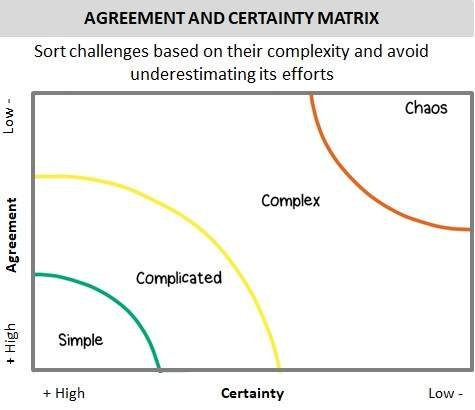
Everything is easier with the Agreement and Certainty Matrix
Agreement and Certainty Matrix help groups discover which approaches are most effective for the types of challenges they face.
You can help individuals or groups avoid the frequent mistake of trying to solve a problem with methods that are not adapted to the nature of their challenge. The combination of two questions makes it possible to easily sort challenges into four categories: simple, complicated, complex, and chaotic.
A problem is simple when it can be solved reliably with practices that are easy to duplicate. It is complicated when experts are required to devise a sophisticated solution that will yield the desired results predictably.
A problem is complex when there are several valid ways to proceed but outcomes are not predictable in detail. Chaotic is when the context is too turbulent to identify a path forward.
A loose analogy may be used to describe these differences: simple is like following a recipe, complicated like sending a rocket to the moon, complex like raising a child, and chaotic is like the game “Pin the Tail on the Donkey.”

Four Structural Elements
1. Structuring Invitation
- Invite participants to categorize their current challenges as simple, complicated, complex, or chaotic
- Ask them to place every challenge in the matrix based on their answers to two questions: What is the degree of agreement among the participants regarding the challenge and the best way to address it? What is the degree of certainty and predictability about what results will be generated from the solutions proposed for addressing the challenge?
- Ask them to think about the approaches they are using or considering to address each challenge, evaluate how well these fit, and determine where there are mismatches
2. How Space Is Arranged and Materials Needed
- Chairs for people to sit in groups of 4–6, with or without small round tables
- Long open wall with a large tapestry paper illustration of the matrix taped to the wall
- One page with a blank matrix for every participant
- Post-it notes and markers for everybody
3. How Participation Is Distributed
- Everyone involved in the work team or unit under discussion (not only leaders)
- Everyone has an equal opportunity to contribute
- Individually to make initial assessments
- Small groups of 4 to 6
- Whole group
4. Sequence of Steps and Time Allocation
- Ask participants to individually generate the list of challenges that take up their time. 5 min.
- Still working individually, participants place challenges in their individual matrixes. 5 min.
- Ask participants to discuss in pairs. 5 min.
- Invite them to chat with others in a group of 4–6 to find points of agreement, difference, and where there are mismatches. 10 min.
- Invite everyone to post their challenges on the large wall matrix. 5 min.
- Ask participants to form small groups and step back to reflect on, “What pattern do we see? Do any mismatches stand out that we should address?” 5 min.
- Invite whole group to share reflections and decide next steps. 10 min.
Purposes and Objectives
- Reduce wasted effort by matching challenges with methods
- Identify where local experiments may help solve larger problems
- Make visible to everyone the range and the nature of the challenges facing people in the organization
- Reduce the frustration of people not making progress on key challenges by identifying mismatches
- Share perspectives across functions and levels of the organization
Tips
- Clarify what type of challenges and activities are being included
- Work up from the individual, then into pair and table conversations
- Avoid making judgments about where people put their activities
- Explore items that fall into more than one sector by asking, “Does this challenge have multiple dynamics at play? How is it simultaneously simple and complex?”
Examples
- The Agreement-Certainty Matrix can be used at the onset of a change initiative to plot the various challenges. This is a good way to help groups identify which approach works where.
- For introducing managers trained only in linear cause-and-effect analysis to what is different about complex challenges
- For selecting a mix of change methodologies at the start of a new improvement project
- For helping a planning group move beyond “analysis paralysis” into an action phase
- For organizing the projects of a department


